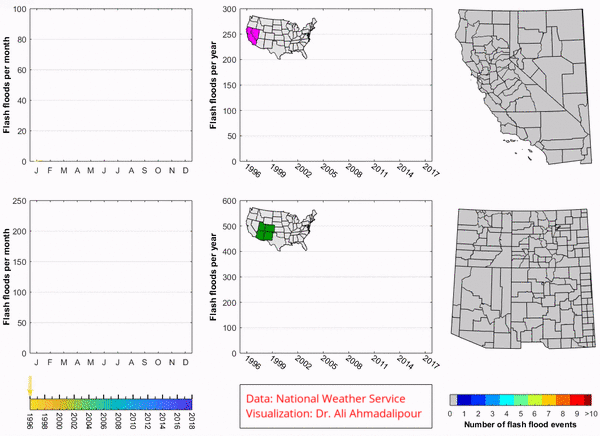ALL NEW FOUNDATIONAL INTELLIGENCE MODEL (FICE) - Get your Insights Report Here
Alex Luna • May 14th, 2020.
The agriculture sector is particularly vulnerable to floods. Floods can inundate farmlands and cause major damage to crops, especially if they strike during planting or harvesting season. In many cases, the damage from a single flood can last multiple seasons if soil health is strongly affected.
The historic flooding that has occurred this year across the Great Plains and Upper Midwest has substantially damaged millions of acres of cropland. Consequently, corn this year was planted at the slowest pace in the past 40 years. Growers were facing a high-stakes decision: postpone planting and risk having a short season, or rely on crop insurance to partially cover their losses.
California is commonly known to be a drought-prone region (especially after the exceptional 2011–2017 California drought), however, much of the state’s ag lands are also highly susceptible to damage by floods. 2017 was one of Northern California’s wettest winters in almost a century. Intense storms inundated farmlands across the state and damaged/destroyed crops causing hundreds of thousands of dollars in damages and raising vegetable prices in farmer’s markets. Early last year in Feb 2019, the USDA offered immediate disaster assistance and loan programs to the flood impacted farmers and ranchers in California, following the heavy rains that happened in early 2019.
It is important to note that the impacts of floods do not end right after flood termination. Since the inundated farms must dry up (that can take several weeks) before the heavy equipment and tractors can enter the land, and next season’s schedule can be pushed back, which can adversely impact the succeeding harvest.
Floods are a recurring natural hazard that humanity has had to deal with since the dawn of civilization. However, it has been demonstrated that the frequency and intensity of floods have increased in recent years as a consequence of climate change and anthropogenic activities. A study published in Journal of Hydrology (JOH) which is led by Dr. Ali Ahmadalipour — director of climate science at ClimateAI — analyzed about 75,000 flash flood events across the contiguous United States during the period of 1996–2017, and investigated the frequency, duration, property damage, and fatalities of these flash floods.
The results indicated that the frequency of flash floods have considerably increased over southwestern U.S. In general, the frequency and intensity of floods have increased in recent years due to global warming, and they are expected to continue to increase in the future. Numerous studies have reported that 100-year floods (which is the level that most flood protection structures such as levees are built to function) will occur 25% — 100% more frequently over the next couple of decades.

In addition to the frequency of flash floods, the recently published Journal of Hydrology study has also analyzed the seasonality or the “timing” of flash floods. The analysis shows that the majority of flash floods occur between May and September, which is the prime harvesting time for many crops. In south and central California, for instance, more than 30 different crops and vegetables are harvested during the peak flash flood season (Jul, Aug, and Sep), some of which only grow in that particular period including blackberries, boysenberries, eggplants, potatoes, and sweet potatoes.
Understanding the climatic conditions such as the atmospheric and oceanic states that increase the likelihood of flooding and predicting them weeks to months ahead of time is essential for implementing proactive flood risk management strategies to increase agricultural resilience and mitigate damages.
In addition, it is imperative to assess the vulnerability of seed varieties at different locations and with regards to extreme weather conditions, and integrate that with seasonal weather forecast to attain a resilient and thriving agricultural industry. Artificial intelligence techniques and cloud computing are powerful tools that can be employed to characterize patterns and attributes of extreme weather events (such as floods), predict their emergence time and intensity, and assess their impacts on agricultural productivity.
At ClimateAi, we are using a combination of our patented AI technology along with dynamical models to develop robust and reliable probabilistic seasonal weather forecasts at farm scale to facilitate and enhance the decisions made by growers, seed providers, and insurance companies. Our hybrid methodology leverages the most advanced deep learning techniques and improves the accuracy of the data obtained from the state-of-the-art climate models.